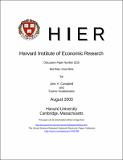| dc.contributor.author | Campbell, John | |
| dc.contributor.author | Vuolteenaho, Tuomo | |
| dc.date.accessioned | 2009-06-26T13:19:49Z | |
| dc.date.issued | 2004 | |
| dc.identifier.citation | Campbell, John Y., and Tuomo Vuolteenaho. 2004. Bad Beta, Good Beta. American Economic Review 94(5): 1249-1275. | en |
| dc.identifier.issn | 0002-8282 | en |
| dc.identifier.uri | http://nrs.harvard.edu/urn-3:HUL.InstRepos:3122489 | |
| dc.description.abstract | This paper explains the size and value "anomalies" in stock returns using an economically motivated two-beta model. We break the beta of a stock with the market portfolio into two components, one reflecting news about the market's future cash flows and one reflecting news about the market's discount rates. Intertemporal asset pricing theory suggests that the former should have a higher price of risk; thus beta, like cholesterol, comes in "had" and "good" varieties. Empirically, we find that value stocks and small stocks have considerably higher cash-flow betas than growth stocks and large stocks, and this can explain their higher average returns. The poor performance of the capital asset pricing model (CAPM) since 1963 is explained by the fact that growth stocks and high-past-beta stocks have predominantly good betas with low risk prices. | en |
| dc.description.sponsorship | Economics | en |
| dc.language.iso | en_US | en |
| dc.publisher | American Economic Association | en |
| dc.relation.isversionof | http://dx.doi.org/10.1257/0002828043052240 | en |
| dash.license | LAA | |
| dc.title | Bad Beta, Good Beta | en |
| dc.relation.journal | American Economic Review | en |
| dash.depositing.author | Campbell, John | |
| dc.identifier.doi | 10.1257/0002828043052240 | * |
| dash.contributor.affiliated | Campbell, John | |


